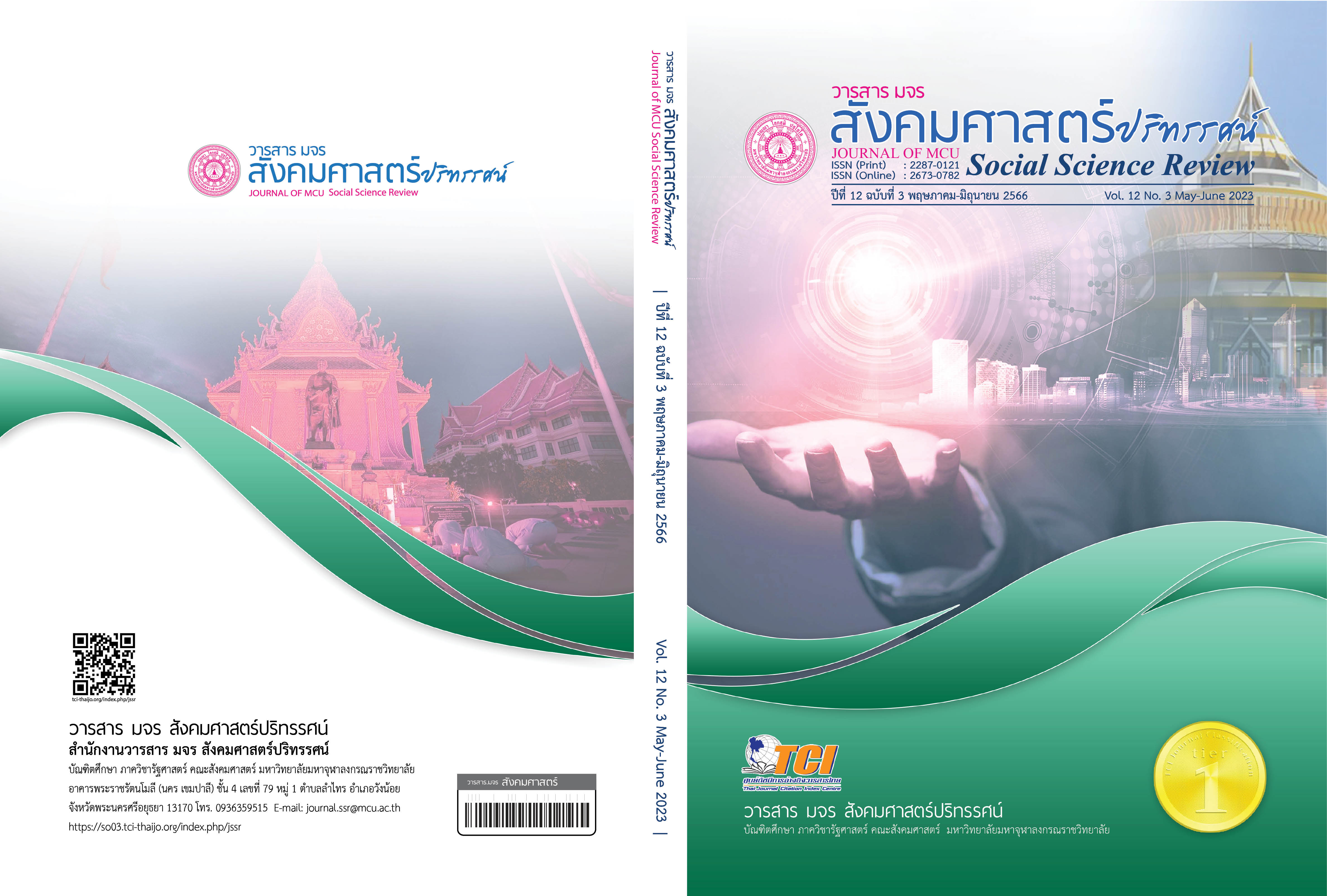การพัฒนาประสิทธิผลของธุรกิจแปรรูปผลไม้ในจังหวัดจันทบุรี
คำสำคัญ:
การพัฒนา, ประสิทธิผล, ธุรกิจแปรรูปผลไม้บทคัดย่อ
งานวิจัยครั้งนี้มีวัตถุประสงค์เพื่อ 1. ศึกษาสภาพคุณลักษณะความเป็นผู้ประกอบการ ความคิดสร้างสรรค์ ความสามารถทางนวัตกรรม และประสิทธิผลธุรกิจแปรรูปผลไม้จันทบุรี 2. วิเคราะห์องค์ประกอบเชิงยืนยันของปัจจัยเชิงสาเหตุที่มีอิทธิพลต่อประสิทธิผลธุรกิจแปรรูปผลไม้ 3. ศึกษาความสัมพันธ์เชิงสาเหตุประสิทธิผลธุรกิจแปรรูปผลไม้ และ 4. ศึกษาแนวทางการพัฒนาประสิทธิผลธุรกิจแปรรูปผลไม้ กลุ่มตัวอย่างคือ ผู้ประกอบการและบุคลากรของสถานประกอบการแปรรูปผลไม้ในจังหวัดจันบุรี จำนวน 970 คน
ผลการวิจัยพบว่า 1. คุณลักษณะความเป็นผู้ประกอบการ อยู่ในระดับสูง ส่วนความคิดสร้างสรรค์ ความสามารถทางนวัตกรรม และประสิทธิผล อยู่ในระดับต่ำ 2. องค์ประกอบเชิงยืนยันตามแบบจำลองสมการโครงสร้าง มีค่า Chi-square = 116.05, df = 115, p-value = 0.4549, RMSEA = 0.009 และมีค่าน้ำหนักองค์ประกอบ > 0.50 ทุกตัวแปร และ 3. ประสิทธิผลธุรกิจแปรรูปผลไม้ในจังหวัดจันทบุรี ได้รับได้รับอิทธิพลทางตรงมาจาก 2 ปัจจัย คือ ปัจจัยด้านคุณลักษณะความเป็นผู้ประกอบการ อยู่ในระดับต่ำ (DE = 0.20) ปัจจัยด้านความคิดสร้างสรรค์ อยู่ในระดับปานกลาง (DE = 0.76) และในขณะเดียวกันได้รับอิทธิพลทางอ้อมจากปัจจัยด้านคุณลักษณะความเป็นผู้ประกอบการ ในระดับปานกลาง (IE = 0.63) และปัจจัยด้านความคิดสร้างสรรค์ ในระดับปานกลาง (IE = 0.69) โดยส่งผ่านปัจจัยด้านความสามารถทางนวัตกรรม โดยปัจจัยทั้งหมดดังกล่าว สามารถทำนายตัวแปรตามคือ ประสิทธิผลธุรกิจแปรรูปผลไม้ในจังหวัดจันทบุรี ได้ร้อยละ 89 อย่างมีนัยสำคัญที่ระดับ .05 และ 4. นำเสนอแนวทางการเพื่อพัฒนาประสิทธิผลธุรกิจแปรรูปผลไม้ในจังหวัดจันทบุรี
เอกสารอ้างอิง
ฐานันท์ ตั้งรุจิกุล และคณิดา ไกรสันติ. (2560). แนวทางการพัฒนาศักยภาพการดำเนินงานของ วิสาหกิจชุมชนกลุ่มแม่บ้านเกษตรกรบ้านลานไทร อำเภอนาหม่อม จังหวัดสงขลา. สงขลา: มหาวิทยาลัยหาดใหญ่
วันวิสาข์ โชคพรหมอนันต์. (2559). คุณลักษณะของผู้ประกอบการที่มีต่อความสำเร็จในการดำเนินธุรกิจของผู้ประกอบการร้านค้าในตลาดน้ำดอนหวาย จังหวัดนครปฐม. วารสาร Veridian E-Journal,Silpakorn University ฉบับภาษาไทย สาขามนุษยศาสตร์ สังคมศาสตร์ และศิลปะ, 9(2), 967-988.
วัชรพงษ์ อินทรวงศ์ และปัททมา สุริยกุล ณ อยุธยา. (2561). การศึกษาปัจจัยเชิงสาเหตุด้านภาวะผู้ประกอบการและนวัตกรรมที่มีต่อผลการดำเนินงาน ของกลุ่มวิสาหกิจชุมชน แปรรูปอาหารจังหวัดนครพนม. วารสารชุมชนวิจัย มหาวิทยาลัยราชภัฏนครราชสมา, 12(2), 101-117.
ศูนย์วิจัยกสิกรไทย. (2559). นวัตกรรมและเทคโนโลยี. สืบค้น 25 มิถุนายน 2562, จาก https://www.kasikornbank.com.
ฝนทิพย์ ฆารไสว. (2555). การศึกษาคุณลักษณะของผู้ประกอบการที่ประสบความสำเร็จของธุรกิจโรงแรม ในจังหวัดภาคเหนือตอนล่างของไทย. วารสารวิทยาการจัดการและสารสนเทศศาสตร์ มหาวิทยาลัยนเรศวร, 7(1), 39-50.
สมนึก เอื้อจิระพงษ์พันธ์. (2553). รูปแบบการพัฒนาความสามารถในการจัดการความรู้ของผู้ประกอบการที่มีนวัตกรรมในประเทศไทย. สืบค้น 25 มิถุนายน 2562, จาก https://doi.nrct.go.th/ListDoi/listDetail.
สำนักงานส่งเสริมวิสาหกิจขนาดกลางและขนาดย่อม. (2556). รายงานสถานการณ์วิสาหกิจขนาดกลางและขนาดย่อม ปี 2556 และแนวโน้มปี 2557. กรุงเทพฯ: สำนักงานส่งเสริมวิสาหกิจขนาดกลางและขนาดย่อม.
Allen, K.R. (2006). Launching New Ventures: An Entrepreneurial Approaching. (4th ed.). Boston: Houghton Mifflin.
Andriopoulos, C. & Lowe, A. (2000). Enhancing organisational creativity: the process ofperpetual challenging. Management Decision, 38(10), 734 – 742.
Chen, X. Y., et al., (2010). Using the balanced scorecard to measure Chinese and Japanese hospital. performance at Retrieved June 15, 2021, from www.emeraldinsignt.com.
Diamantopoulos, A. & Siguaw, J. A. (2000). Introducing LISREL: A guide for the uninitiated, London: Sage Publications.
Ferreira, J. and Azevedo, S. (2007). Entrepreneurial Orientation as a main Resource and Capability on Small Firm’s Growth. Retrieved May 2, 2019, from http://mpra.ub.uni-muenchen.de/5682/MPRA.
Guilford, J.P. and Hoepfner, R. (1971). The analysis of Intelligence. New York: McGraw-Hill Book Company.
Hatten, T.S. (2006). Small Business Management: Entrepreneurship and Beyond. (3rded.). Boston, MA: Houghton Mifflin.
Hitt, M.A. et al., (1997). International diversification: Effects on innovation and firm performance in product-diversified firms. Academy of Management Journal, 40(4), 767-798.
Hooper, D., et al., (2008). Structural Equation Modeling: Guidelines for Determining Model Fit. Electronic Journal of Business Research Methods, 6(1), 53-60.
Kaplan, R.S., and Norton, D. P. (1992). “The balanced scorecard-measures that drive performance.” Harvard Business Review, 83(7-8), 172-180.
Krejcie, R. V. and Morgan, D. W. (1970). Determining Sample Size for Research Activities. Educational and Psychological Measurement, 30(3), 607-610.
Lim Seongbae. (2009). Entrepreneurial Orientation and The Performance of Service Business. Retrieved March 7, 2009, from www.decisionsciences.org/Proceedings/ DSI2008/docs/392-9586.pdf
McGregor, D. (2007). Developing Thinking; Developing Learning: A Guide to Thinking Skills in Education. New York: Open University Press.
Morris, M.H. and Kuratko, D. F. (2002). Corporate Entrepreneurship, Mason, OH: South-Western College Publishers.
ดาวน์โหลด
เผยแพร่แล้ว
รูปแบบการอ้างอิง
ฉบับ
ประเภทบทความ
สัญญาอนุญาต
ลิขสิทธิ์ (c) 2023 วารสาร มจร สังคมศาสตร์ปริทรรศน์

อนุญาตภายใต้เงื่อนไข Creative Commons Attribution-NonCommercial-NoDerivatives 4.0 International License.
เพื่อให้เป็นไปตามกฎหมายลิขสิทธิ์ ผู้นิพนธ์ทุกท่านต้องลงลายมือชื่อในแบบฟอร์มใบมอบลิขสิทธิ์บทความให้แก่วารสารฯ พร้อมกับบทความต้นฉบับที่ได้แก้ไขครั้งสุดท้าย นอกจากนี้ ผู้นิพนธ์ทุกท่านต้องยืนยันว่าบทความต้นฉบับที่ส่งมาตีพิมพ์นั้น ได้ส่งมาตีพิมพ์เฉพาะในวารสาร มจร สังคมศาสตร์ปริทรรศน์ เพียงแห่งเดียวเท่านั้น หากมีการใช้ภาพหรือตารางหรือเนื้อหาอื่นๆ ของผู้นิพนธ์อื่นที่ปรากฏในสิ่งตีพิมพ์อื่นมาแล้ว ผู้นิพนธ์ต้องขออนุญาตเจ้าของลิขสิทธิ์ก่อน พร้อมทั้งแสดงหนังสือที่ได้รับการยินยอมต่อบรรณาธิการ ก่อนที่บทความจะได้รับการตีพิมพ์ หากไม่เป็นไปตามข้อกำหนดเบื้องต้น ทางวารสารจะถอดบทความของท่านออกโดยไม่มีข้อยกเว้นใดๆ ทั้งสิ้น





